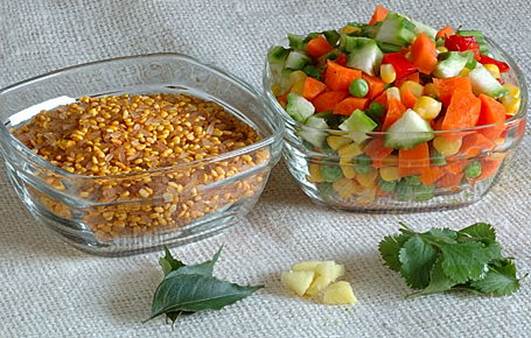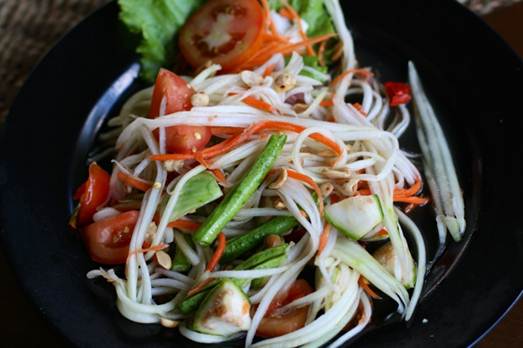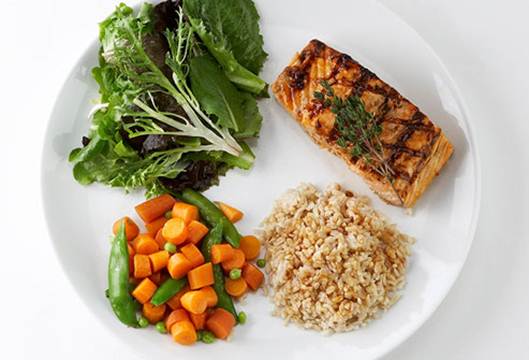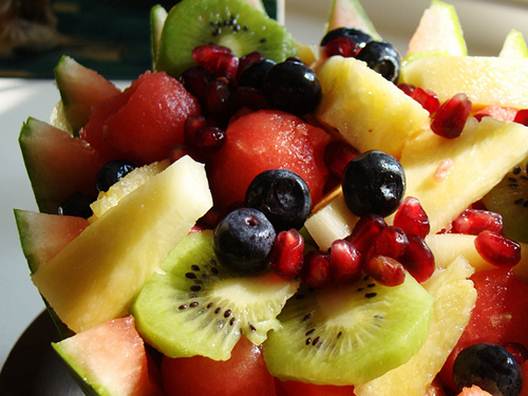Seek contrast
Retreat-center chefs know that one of the
keys to making healthful food appealing is to include a variety of colors and
textures in each dish. “That old saying ‘We eat first with our eyes’ applies to
everything I prepare,” says Roa. “The bold use of color is very appetizing and
so easy [to achieve] in all seasons with vegetables.”
Kerala
Red Rice+Roasted Yellow Moong Dal, Vegetables, Curry leaves
In your own cooking, think about balancing
colors and textures as well as flavors. Tops a bowl of rice and colorful
curried vegetables with crunchy toasted peanuts, shaved coconut, and a few torn
fresh cilantro leaves. Add crisp, paper-thin slices of raw fennel to a salad of
roasted red and gold beets and curly baby spinach leaves. Accompany a smoothly
pureed red pepper soup with a dollop of bright pesto and a crunchy toasted crouton.
When your food is a sensory pleasure, you’ll enjoy it until the last bite.
Add a flavorful finishing touch

papaya
salad
A drizzle of flavored vinegar, a squeeze of
lime or lemon juice – bright, acidic ingredients like these are one of the
reasons that dishes prepared for you on retreat sing with flavor. To put
flavorful finishing touches on dishes you cook at home, experiment with freshly
squeezed citrus juice and see how just a teaspoon or two can highlight the
flavor of soups, salads, vegetables, and fresh fruit.
In addition to fresh lime juice, mild rice
vinegar is a favorite ingredient of Inglizian, who drizzles it over slices of
cucumber and papaya to make a sweet and tangy salad. “It’s so simple,” she
says, “but it really stands out to people.”
Be in balance

you
should eat your biggest meal of the day at midday
Conventional wisdom says you should eat
your biggest meal of the day at midday, with a lighter meal in the evening. But
warm weather and activity-filled days call for light, easily digested midday
meals that leave you satisfied but not so full that you’re groggy in the
afternoon.
At Prana del Mar in Los Cabos, Mexico,
guest have a light snack of fruit first thing in the morning, followed by a
heartier breakfast after morning practice. The midmorning meal “gives that
digestive fire substantial fuel for the rest of the day, to help with the
recovery of the muscles and to energize the more subtle systems of the body,”
says founder Erik Singer. Since afternoon practice is only a few hours away,
lunch is a lighter meal that might include salad greens, whole grains, and lots
of fresh fruit and veggies.
Whether your days are filled with meetings
and carpools or yoga classes and beach time, you can balance your energy
throughout the day by eating lightly before periods of activity and making
every meal a combination of fresh produce, whole grains, and protein-rich plant
foods such as beans and legumes. “For the midday meal, I like to focus on
complex carbohydrates like wild rice, quinoa, and all sorts of beans,” says
Jean-Baptiste Belledent, the owner of Xinalani in Puerto Vallarta. “This takes
care of the high energy needs of the day instead of giving you peaks of power
and letting you down when you really need it.”
Sate your sweet tooth natural

sweet
tooth natural
When you satisfy your sweet tooth
retreat-style, you might be surprised at how the taste of foods like fresh
fruit, dates, coconut, and raw honey edges out the desire for more refined,
processed desserts. Shift your palate by making a habit of indulging in
naturally sweet treats. At Xinalani, the cooks blend ripe mango pulp and freeze
it for a smooth sorbet without added sugar, something you could also try with
ripe strawberries, peaches, or melon, “The natural sweetness of fruit gives you
the same rush of pleasure and energy,” Belledent says.
At Sagrada Wellness,, Inglizian makes an
icy, thirst-quenching agua fresca form just three ingredients: ripe watermelon,
fresh lime juice, and water. “You could add a little agave if you like, but usually
the pure sweetness of the watermelon is enough,” she says.